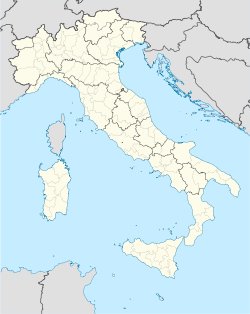- Acquaviva Collecroce
-
Acquaviva Collecroce — Comune — Comune di Acquaviva Collecroce 
Coat of armsLocation of Acquaviva Collecroce in Italy Coordinates: 41°52′N 14°45′E / 41.867°N 14.75°ECoordinates: 41°52′N 14°45′E / 41.867°N 14.75°E Country Italy Region Molise Province Campobasso (CB) Government – Mayor Enrico Fagnani Area – Total 28 km2 (10.8 sq mi) Elevation 425 m (1,394 ft) Population (31 August 2007) – Total 733 – Density 26.2/km2 (67.8/sq mi) Demonym Acquavivesi Time zone CET (UTC+1) – Summer (DST) CEST (UTC+2) Postal code 86030 Dialing code 0875 Patron saint St. Mary Esther Saint day 29 September Website Official website Acquaviva Collecroce (also called Živavoda Kruč or, usually, just Kruč) is a small town and comune in the province of Campobasso, in the Molise region of southern Italy, between the Biferno and Trigno rivers.
Like the smaller towns of Montemitro and San Felice del Molise, Acquaviva Collecroce is home to a community of Molisian Croats, most of whom speak a particular Croatian dialect (known as simply na-našo or naš jezik, meaning "our language") as well as Italian. There are differences in the dialects of the three towns, but they all descend from the Shtokavian-Ikavian dialect of Dalmatia. The language is considered an endangered diaspora language.
Acquaviva is known for the production of a small, dark, zerniza figs grown there, as well as the fennel and white celery.
Contents
History
In the 12th century, Acquaviva was a base for the Knights of Malta.
Though there is evidence of an earlier Slavic settlement in 1297, it is believed that the current inhabitants are not their descendants, but rather come from later migrations in the 15th and 16th centuries.[1] These migrations may have been caused by Ottoman incursions into the Balkans.
Numerous inhabitants emigrated in two flows during the 20th century, and population is currently still decreasing (there were some 2,500 inhabitants in 1951, compared to the c. 730 of 2007). The first emigration took place between, roughly, 1900–1920, the emigrees heading towards the United States and Argentina. The second major flow took place in the 1950s, chiefly to Australia.
Culture
Every 1 May, the town celebrates the Festa del Maja by parading a puppet (the pagliara maja) as a good omen for the harvest
References
- ^ Milan Rešetar, Le colonie serbocroate nell'Italia Meridionale, 1911. (Reprinted in 1996.)
External links
- Official website
- UNESCO Red Book on endangered languages and dialects: Europe
- The coat of arms of Acquaviva Collecroce
- Acquaviva Online
Categories:- Cities and towns in Molise
- Communes of the Province of Campobasso
Wikimedia Foundation. 2010.

